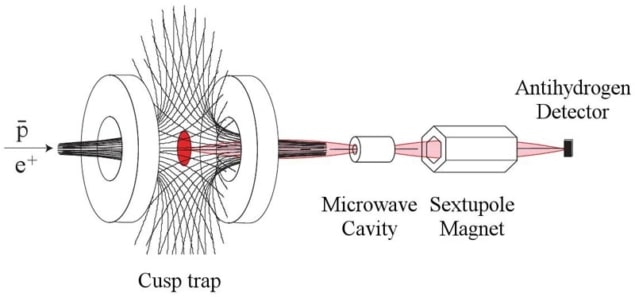
Physicists at CERN have taken a big step towards making the first spectroscopic measurements on a beam of antihydrogen atoms. The antihydrogen atoms, which consist of an antielectron orbiting an antiproton, were made by members of the lab’s ASACUSA group. The beams could be used to carry out the first detailed studies of the energy levels in antihydrogen.
Measuring in detail the energy levels in antihydrogen is important because the Standard Model of particle physics says they should be identical to those of hydrogen. Any slight differences in the “fine structure” of the levels compared to ordinary hydrogen could shed light on why there is so much more matter than antimatter in the universe.
The breakthrough comes just weeks after researchers in the ALPHA collaboration at CERN succeeded in trapping 38 antihydrogen atoms for about 170 ms. This was the first time antimatter atoms had been stored for long enough to measure their properties in detail and, taken together, the two results represent major advances in studies of antimatter.
Trapped in a cusp
The ASACUSA researchers, however, used an alternative technique for creating antihydrogen. Led by Yasunori Yamazaki of the RIKEN laboratory in Japan, they created their antiatom beams by combining antiprotons with positrons in a “cusp trap”.
The trap comprises 17 successive ring-shaped electrodes and two magnetic coils, which are wired to create magnetic fields in opposite directions (see figure). A cloud of antielectrons (also called positrons) from a radioactive source is first sent into the trap, where it is held as a plasma. A cloud of antiprotons – created in a nearby accelerator – is then fired into the plasma to create the antihydrogen atoms.
Charged particles remain stuck in the trap, while neutral antihydrogen atoms are able to move further along the apparatus to a “field ionization trap”. At this point, antihydrogen atoms in highly excited Rydberg states, in which the positron lies very far from the antiproton, are ionized and their antiprotons are trapped.
Detecting pions
The trapped antiprotons are then released and quickly annihilate upon contact with the walls of the trap. Each annihilation event creates pions, which are easily spotted by a bank of detectors surrounding the trap. By comparing the number of antiprotons injected into the trap with the number of annihilations detected, the team estimated that about 7% of antiprotons combine to form antihydrogen.
The team is now trying to improve the way in which antihydrogen is extracted from the trap before passing it through a microwave cavity in which hyperfine transitions between atomic energy states should occur. Making precise measurements of these transitions, which have not yet been carried out, could be used to study a fundamental quantum transformation known as the charge-parity-time (CPT) operation.
When applied to a physical system, a CPT transformation converts every particle to its antiparticle, reflects each spatial co-ordinate, and reverses time. Although is currently no experimental evidence that the CPT symmetry is violated, it could show up as a slight difference in the frequency of hyperfine transitions in hydrogen and antihydrogen atoms. The discovery of such a violation could also help physicists understand why there is much more matter than antimatter in the universe.
The work is reported in Phys. Rev. Lett. 105 243401.



